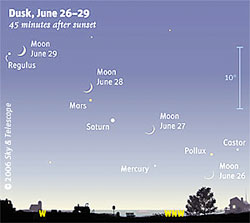 If you are new to astronomy, perhaps one of the most difficult and daunting parts about beginning is learning all those stars. Relax! It's a lot easier than you think. Just like moving to a new city, everything will be unfamiliar at first but with a little help from some maps, you'll soon be finding your way around like a pro. Once you become familiar with the constellations and how they appear to move across the night sky, the rest is easy.
If you are new to astronomy, perhaps one of the most difficult and daunting parts about beginning is learning all those stars. Relax! It's a lot easier than you think. Just like moving to a new city, everything will be unfamiliar at first but with a little help from some maps, you'll soon be finding your way around like a pro. Once you become familiar with the constellations and how they appear to move across the night sky, the rest is easy.
And what better time to learn it than in the monsoon. It may be usually cloudy, but clear monsoon nights are dust-free and clear enough to see the milky way if you're lucky. Anyone even vaguely interested in the night sky should own a pair of binoculars. While they will never reveal the heavens in quite as much detail as even a small telescope, their availability, ease of use and portability make them the perfect night sky companion.
Now is the perfect time to try out those new binoculars because as if to celebrate the change of the seasons, four of our solar system's bright planets are putting on a parade at dusk during the last week of June. One of them - giant Jupiter - gleams brilliantly overhead as it gets dark. You can't miss it; it's the brightest point of light in the sky these evenings. You might easily overlook the other three worlds - Mercury, Mars, and Saturn - which are much fainter and setting in the west during twilight. Thankfully the waxing crescent Moon comes to the rescue, pointing the way to the planetary trio. And your eyes are all you need to enjoy the spectacle - no telescope required!
Mars currently shares Cancer with Saturn. Hope you enjoyed the Mars-Saturn conjunction in mid June as Mars approached very close to the ringed-planet.
Among constellations, Scorpius is now highest near the end of evening twilight. This magnificent constellation is a favourite of serious sky watchers. You might wish to see the bright reddish star Antares at the heart of the scorpion. Another prominent star, Spica, of the constellation Virgo, lies close to an imaginary line through the zodiac known as the ecliptic which represents the plane of the Earth's orbit projected against the stars.
Late July, after evening twilight, the Milky Way Galaxy bubbles up from the southern horizon, traverses high across the eastern sky and dips down in the north. Look south and you stare into the Sagittarius Spiral Arm and the centre of our galaxy.
Don't Miss the Great Hercules Star Cluster (M13) through binoculars on 29 July after the moon sets.
Other July highlights:
The Sun & the Earth: The Sun is in the constellation of Gemini at the start of July, moving into Cancer on the 20th. On 4 July, Earth reaches aphelion, ie, the point farthest from the Sun, at about 94,512,000 miles. If you still hold the notion that summer occurs because the sun is closest to us, this is the perfect occasion to revise that idea.
Mercury: Mercury is moving closer to the Sun and on 18 July it will go through inferior conjunction (in front of the Sun) to become a morning object, visible early August.
Venus: Venus is a brilliant morning star, coming up about two hours before sunrise. It is easy to pick out even in the dawn twilight.
Mars: Mars may be seen low in the western sky at sunset but it slips steadily downwards into the evening twilight.
Jupiter: The giant planet Jupiter is overhead at dusk and sets after midnight. On 5 July, the gibbous Moon will appear directly below Jupiter.
Saturn: Saturn is almost behind the Sun, and won't be visible this month.
Meteors: For meteor enthusiasts, the Delta Aquarid meteor shower reaches its peak on 29 July, producing a meteor every 4 or 5 minutes on average. But its peak is broad, lasting a week or so and overlapping with the beginning of the well-known Perseid shower.


